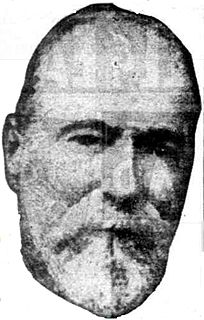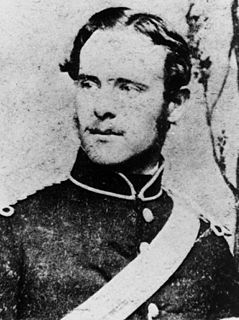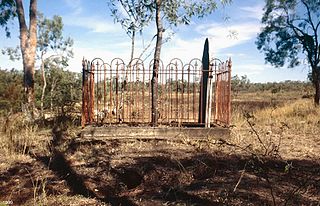
William Hann (1837 - 1889) was a pastoralist and explorer in northern Queensland, Australia. His expedition in 1872 found the first indications of the Palmer River goldfield.

William Hann (1837 - 1889) was a pastoralist and explorer in northern Queensland, Australia. His expedition in 1872 found the first indications of the Palmer River goldfield.
He was born in Wiltshire, England, on 26 February 1837. Fellow explorer Frank Hann was his younger brother.
The first gold was found by Frederick Warner the expedition's surveyor on 6 August and further deposits were located on following days. However Hann thought they were not in commercial quantity; as a result James Venture Mulligan who in 1873 followed up Hann's report and announced richer deposits is credited with the discovery.
A death notice from The Queenslander , Brisbane, dated 11 May 1889 said: [1]
"HANN--On the 5th April, William HANN, of Maryvale, North Queensland, accidentally drowned whilst bathing in the sea at Townsville, leaving a wife and two daughters to mourn the loss of an affectionate husband and loving father, aged 52."
In addition to the above death notice, the following article appeared in the Brisbane Courier, dated 6 April 1889, suggesting that the drowning was not accidental and took place at night. [2]
"A Townsville telegram dated 5 April states that William Hann of Maryvale Station, one of the oldest of the northern pioneers, committed suicide by drowning, in the bay in front of the Queen's Hotel during Thursday night."

A memorial to William Hann was erected in 1959 in Lissner Park in Charters Towers. The stone used in the memorial was taken from Basalt River near the Bluff Downs homestead where William Hann first settled. [3]

Frank Hugh Hann was an Australian pastoralist and explorer, the son of Joseph and Elizabeth Hann. Fellow explorer William Hann was his older brother. They were born in Wiltshire, England and migrated with the family to the Western Port area of Victoria in 1851. In 1862 the family moved to the Burdekin River district, just north of Charters Towers in Queensland.

Wujal Wujal is a rural town and locality in the Wujal Wujal Aboriginal Shire, Queensland, Australia. In the 2016 census, Wujal Wujal had a population of 282 people. It is an Aboriginal community.

James Venture Mulligan was an Ireland-born Australian prospector and explorer.

Mossman Gorge is a rural locality in the Shire of Douglas, Queensland, Australia. In the 2016 census, Mossman Gorge had a population of 246 people.

Archibald Meston was an Australian politician, civil servant, journalist, naturalist and explorer.

William Aplin was an Australian pioneer, businessman and politician of Queensland, Australia in the 19th century.

The Tully River is a river located in Far North Queensland, Australia.

The Colony of Queensland was a colony of the British Empire from 1859 to 1901, when it became a State in the federal Commonwealth of Australia on 1 January 1901. At its greatest extent, the colony included the present-day State of Queensland, the Territory of Papua and the Coral Sea Islands Territory.

Cristofero Palmerston Carandini or Christopher "Christie" Palmerston was an Australian explorer and prospector in North Queensland. He led several expeditions during the last quarter of the 19th century including the discovery of a route along the Mowbray River, which eventually led to the founding of Port Douglas.

Alexander Douglas Douglas was a naval officer, an inspector in the Native Police and a chief inspector of police in Queensland.

Elderslie Station, also known as Elderslie, is a pastoral lease that operates as a sheep and cattle station in Queensland, Australia.

The Shire of Toombul was a local government area of Queensland, Australia, located in northern Brisbane from 1883 to 1925.

St Mary's Anglican Church, often called now St Mary's-on-the-Cliffs, is a heritage-listed churchyard at 433, 447 & 449 Main Street, Kangaroo Point, Queensland, Australia. It was designed by Richard George Suter and built in 1873 by Alfred Grant. It was added to the Queensland Heritage Register on 21 October 1992. Kangaroo Point Cliffs Park was constructed to the church's south in 2010 and a gateway allows park users to visit the church's grounds.

Francis Drummond Greville Stanley (1839—1897) was an architect in Queensland, Australia. He was the Queensland Colonial Architect. Many of his designs are now heritage-listed buildings.

Francis Lookout is a heritage-listed cemetery at 157 Dewar Terrace, Corinda, Brisbane, Queensland, Australia. It was built from 1863 to 1966. It is also known as Francis Outlook. It was added to the Queensland Heritage Register on 7 September 2004.

James Venture Mulligan's Grave is a heritage-listed grave at Bakers Road, Mount Molloy, Shire of Mareeba, Queensland, Australia. It was built in 1907. It is also known as Mount Molloy Cemetery. It was added to the Queensland Heritage Register on 21 October 1992.

Hann Family Grave is a heritage-listed cemetery at Bluff Downs Station, Basalt, Charters Towers Region, Queensland, Australia. It was built from 1864 to 1865. It was added to the Queensland Heritage Register on 24 June 1999.

Robert Arthur Johnstone was an officer in the Native Police paramilitary force which operated in the British imperial colony of Queensland. He was stationed at various locations in central and northern Queensland between 1867 and 1880 conducting regular punitive expeditions against clans of Indigenous Australians who resisted British invasion. He also participated in several surveying expeditions in Far North Queensland, including those under the leadership of George Elphinstone Dalrymple, providing well-armed protection for the British explorers. As a result of being at the frontier of British colonial expansion in this region of Australia, a number of geographical and zoological entities are named after him, such as the Johnstone River and the freshwater crocodile. After resigning from the Native Police in 1880, Johnstone was a police magistrate in various locations around Queensland before he retired from government service in 1891. In his years of duty for the Native Police, Johnstone led many punitive expeditions and "dispersals". Whilst the activities of the Native Police were consistent with both Government policy and popular expectation, thousands of Aboriginal people were killed or displaced from their traditional lands by the Native Police.

John Bye Durnford Marlow was an officer in the paramilitary Native Police force in the British colony of Queensland. He served in this corps for fourteen years and was stationed at frontier sites such as the Maranoa Region, Port Denison and on the Burdekin River. He conducted many punitive expeditions against Indigenous Australians resulting in the indiscriminate deaths of hundreds of these people. Marlow, by leading armed escorts of troopers, was also intrinsically involved in the expeditions which led to the establishment of the towns of Cardwell and Townsville.

William Alexander Jenyns Boyd (1842-1928) was a journalist and schoolmaster in Australia. He was admired for his "upright bearing and extensive learning".
![]()